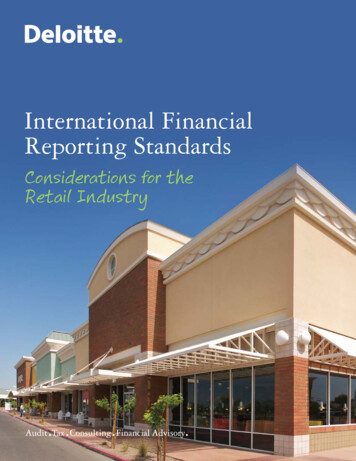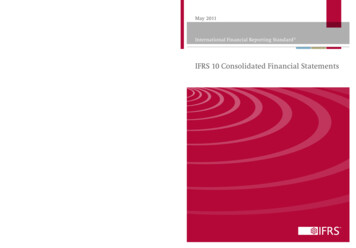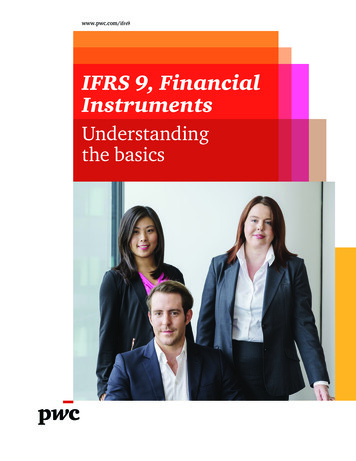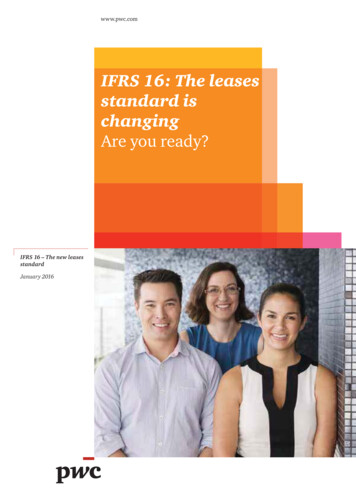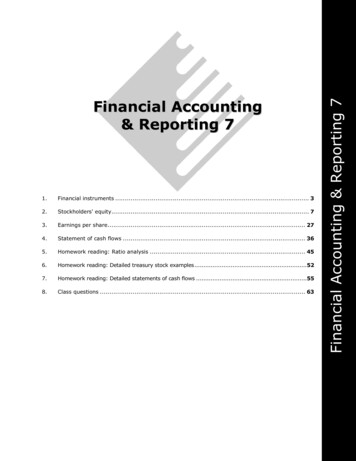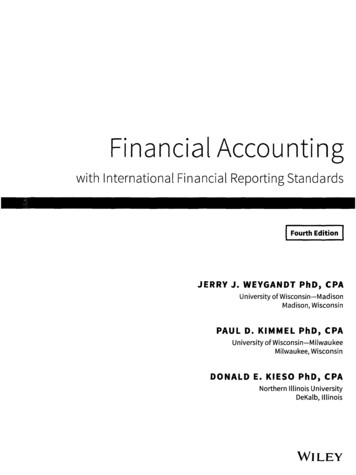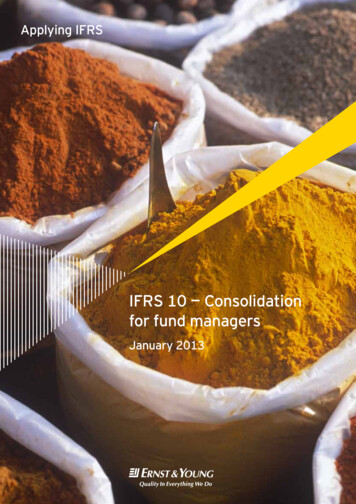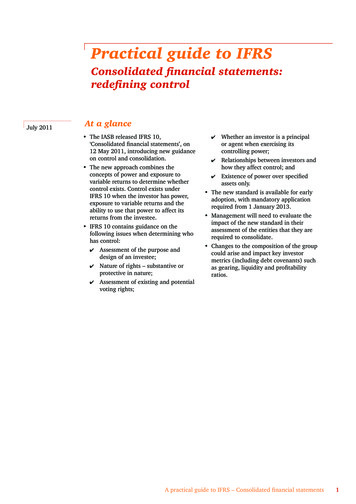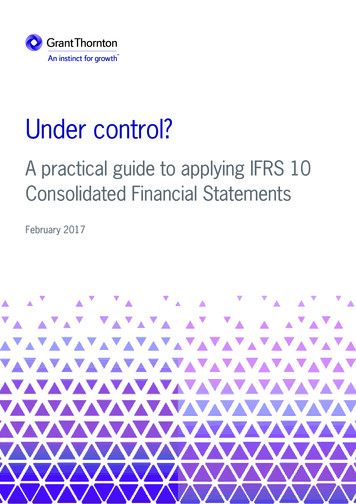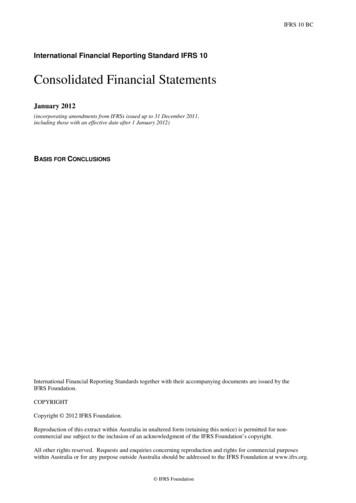
Transcription
IFRS 10 BCInternational Financial Reporting Standard IFRS 10Consolidated Financial StatementsJanuary 2012(incorporating amendments from IFRSs issued up to 31 December 2011,including those with an effective date after 1 January 2012)BASIS FOR CONCLUSIONSInternational Financial Reporting Standards together with their accompanying documents are issued by theIFRS Foundation.COPYRIGHTCopyright 2012 IFRS Foundation.Reproduction of this extract within Australia in unaltered form (retaining this notice) is permitted for noncommercial use subject to the inclusion of an acknowledgment of the IFRS Foundation’s copyright.All other rights reserved. Requests and enquiries concerning reproduction and rights for commercial purposeswithin Australia or for any purpose outside Australia should be addressed to the IFRS Foundation at www.ifrs.org. IFRS Foundation
IFRS 10 BCCONTENTSfrom paragraphBASIS FOR CONCLUSIONS ON IFRS 10CONSOLIDATED FINANCIAL STATEMENTSINTRODUCTIONBC1The structure of IFRS 10 and the Board’s decisionsBC8PRESENTATION OF CONSOLIDATED FINANCIAL STATEMENTS(2003 REVISION)BCZ12Exemption from preparing consolidated financial statementsBCZ12Unanimous agreement of the owners of the minority interestsBCZ16Exemption available only to non-public entitiesBCZ18SCOPE OF CONSOLIDATED FINANCIAL STATEMENTS(2003 REVISION)BCZ19Scope exclusionsBCZ19Temporary controlBCZ20Severe long-term restrictions impairing ability to transfer funds tothe parentBCZ21Venture capital organisations, private equity entities and similarorganisationsBCZ22CONTROL AS THE BASIS FOR CONSOLIDATIONBC29Reputational riskBC37DEFINITION OF CONTROLBC40PowerBC42Relevant activitiesBC56ReturnsBC60Link between power and returnsBC68Control is not sharedBC69ASSESSING CONTROLBC71Understanding the purpose and design of an investeeBC76Different activities significantly affect the returnsBC81Rights that give an investor powerBC93Delegated power (agency relationships)BC125Relationship with other partiesBC143CONTROL OF SPECIFIED ASSETSBC147CONTINUOUS ASSESSMENTBC149ACCOUNTING REQUIREMENTSBC154Consolidation proceduresBC154Non-controlling interests (2003 revision and 2008 amendments)BCZ155Attribution of losses (2008 amendments)BCZ160 IFRS FoundationB785
IFRS 10 BCChanges in ownership interests in subsidiaries(2008 amendments)BCZ168Loss of control (2008 amendments)BCZ180EFFECTIVE DATE AND TRANSITIONBC191Effective dateBC191TransitionBC195Transitional provisions (2008 amendments)BCZ200WITHDRAWAL OF IAS 27 AND SIC–12BC204SUMMARY OF MAIN CHANGES FROM ED 10BC206COST-BENEFIT CONSIDERATIONSBC207PREVIOUS BOARD APPROVALS AND DISSENTING OPINIONSAPPENDIXAmendments to the Basis for Conclusions on other IFRSsAMENDMENTS TO GUIDANCE ON OTHER IFRSsB786 IFRS Foundation
IFRS 10 BCBasis for Conclusions onIFRS 10 Consolidated Financial StatementsThis Basis for Conclusions accompanies, but is not part of, IFRS 10.IntroductionBC1This Basis for Conclusions summarises the International Accounting StandardsBoard’s considerations in developing IFRS 10 Consolidated Financial Statements.Individual Board members gave greater weight to some factors than to others.Unless otherwise stated, any reference below to IAS 27 is to IAS 27 Consolidated andSeparate Financial Statements, and to IAS 28 is to IAS 28 Investments in Associates.BC2The Board added a project on consolidation to its agenda to deal with divergencein practice in applying IAS 27 and SIC-12 Consolidation—Special Purpose Entities.For example, entities varied in their application of the control concept:BC31(a)in circumstances in which an investor controls an investee but the investorhas less than a majority of the voting rights of the investee (and votingrights are clearly the basis for control).(b)in circumstances involving special purpose entities (to which the notion of‘economic substance’ in SIC-12 applied).(c)in circumstances involving agency relationships.(d)in circumstances involving protective rights.IAS 27 required the consolidation of entities that are controlled by a reportingentity, and it defined control as the power to govern the financial and operatingpolicies of an entity so as to obtain benefits from its activities. SIC-12, whichinterpreted the requirements of IAS 27 in the context of special purpose entities,1placed greater emphasis on risks and rewards. This perceived conflict ofemphasis had led to inconsistent application of the concept of control. This wasaggravated by a lack of clear guidance on which investees were within the scopeof IAS 27 and which were within the scope of SIC-12. As a result, assessing controlsometimes resulted in a quantitative assessment of whether the investor had amajority of the risks. Such tests based on sharp ‘bright line’ distinctions createdstructuring opportunities to achieve particular accounting outcomes.To maintain consistency with the terminology used in the original documents this Basis forConclusions refers to ‘special purpose entities (SPEs)’ when discussing SIC-12 and ‘structuredentities’ when discussing the exposure draft ED 10 Consolidated Financial Statements and the relateddeliberations and redeliberations. SIC-12 described an SPE as an entity that may be created toaccomplish a narrow and well-defined objective, often created with legal arrangements thatimpose strict and sometimes permanent limits on the decision-making powers of its governingboard, trustee or management over the SPE’s operations. ED 10 defined a structured entity as anentity whose activities are restricted to the extent that those activities are, in essence, notdirected by voting or similar rights. IFRS FoundationB787
IFRS 10 BCBC4The global financial crisis that started in 2007 highlighted a lack of transparencyabout the risks to which investors were exposed from their involvement with ‘offbalance sheet vehicles’ (such as securitisation vehicles), including those that theyhad set up or sponsored. As a result, the G20 leaders, the Financial Stability Boardand others asked the Board to review the accounting and disclosure requirementsfor such ‘off balance sheet vehicles’.BC5In developing IFRS 10, the Board considered the responses to ED 10 ConsolidatedFinancial Statements, published in December 2008. Respondents to ED 10 pointedout that the Board and the US Financial Accounting Standards Board (FASB), intheir Memorandum of Understanding, had agreed to work towards developingcommon standards on consolidation by 2011. Therefore, they asked the boards todiscuss the consolidation project jointly to ensure that the ensuing standardscontained identical, not only similar, requirements. As a result, the Board’sdeliberations in developing IFRS 10 were conducted jointly with the FASB fromOctober 2009.BC6The FASB decided in January 2011 that it would not change the consolidationrequirements in US generally accepted accounting principles (GAAP) at this timewith one exception. The FASB tentatively decided that it would propose changesto the consolidation requirements relating to both variable interest entities andvoting interest entities in the context of assessing whether a decision maker is aprincipal or an agent. Those proposals would be similar to the requirementsdeveloped jointly by the IASB and the FASB regarding the principal/agentassessment, which are included in IFRS 10.BC7ED 10 proposed disclosure requirements for consolidated and unconsolidatedinvestees. In its deliberation of the responses to those proposals, the Boarddecided to combine the disclosure requirements for interests in subsidiaries,joint arrangements, associates and unconsolidated structured entities within asingle comprehensive standard, IFRS 12 Disclosure of Interests in Other Entities.The Basis for Conclusions accompanying IFRS 12 summarises the Board’sconsiderations in developing that IFRS, including its consideration of responsesto the disclosure proposals in ED 10. Accordingly, IFRS 10 does not includedisclosure requirements and this Basis for Conclusions does not describe theBoard’s consideration of responses to the proposed disclosure requirements in ED 10.The structure of IFRS 10 and the Board’s decisionsBC8IFRS 10 replaces the requirements and guidance in IAS 27 relating to consolidatedfinancial statements. It also replaces SIC-12. As part of its consolidation project,the Board is examining how an investment entity accounts for its interests insubsidiaries, joint ventures and associates and what, if any, additional disclosuresmight be made about those interests. The Board expects to publish an exposuredraft on investment entities later in 2011.BC9In developing IFRS 10, the Board did not reconsider all the requirements that areincluded in the IFRS. The scope in paragraph 4 and the accounting requirementsfor consolidated financial statements in paragraphs 19–25 and B86–B99 werecarried forward from IAS 27 or SIC-12 to IFRS 10 without being reconsidered bythe Board because their reconsideration was not part of the Board’s consolidationproject.B788 IFRS Foundation
IFRS 10 BCBC10When revised in 2003, IAS 27 was accompanied by a Basis for Conclusionssummarising the considerations of the Board, as constituted at the time, inreaching some of its conclusions in that Standard. That Basis for Conclusions wassubsequently updated to reflect amendments to the Standard. The Board hasincorporated into this Basis for Conclusions material from the Basis forConclusions on IAS 27 that discusses matters that the Board has not reconsidered.That material is contained in paragraphs denoted by numbers with theprefix BCZ. In those paragraphs cross-references to the IFRS have been updatedaccordingly and minor necessary editorial changes have been made.BC11In order to portray the historical background of IFRS 10, the documents recordingthe Board’s approval of the revision of IAS 27 in 2003 and the subsequentamendments are set out after this Basis for Conclusions. In addition, in 2003 andlater, some Board members dissented from the revision of IAS 27 and subsequentamendments, and portions of their dissenting opinions relate to requirementsthat have been carried forward to IFRS 10. Those dissenting opinions are set outafter the Basis for Conclusions.Presentation of consolidated financial statements (2003 revision)Exemption from preparing consolidated financialstatementsBCZ12Paragraph 7 of IAS 27 (as revised in 2000) required consolidated financialstatements to be presented. However, paragraph 8 permitted a parent that was awholly-owned or virtually wholly-owned subsidiary not to prepare consolidatedfinancial statements. In 2003 the Board considered whether to withdraw oramend this exemption from the general requirement.BCZ13The Board decided to retain an exemption, so that entities in a group that arerequired by law to produce financial statements available for public use inaccordance with International Financial Reporting Standards, in addition toconsolidated financial statements, would not be unduly burdened.BCZ14The Board noted that in some circumstances users can find sufficientinformation for their purposes about a subsidiary from either its separatefinancial statements or the consolidated financial statements. In addition, theusers of financial statements of a subsidiary often have, or can get access to, moreinformation.BCZ15Having concluded that it should retain an exemption, the Board decided tomodify the circumstances in which an entity would be exempt and consideredthe following criteria.Unanimous agreement of the owners of the minorityinterests22BCZ162The 2002 exposure draft proposed to extend the exemption to a parent that is notwholly-owned if the owners of the minority interests, including thosenot otherwise entitled to vote, unanimously agree.IAS 27 (as amended in 2008) changed the term ‘minority interest’ to ‘non-controlling interest’. IFRS FoundationB789
IFRS 10 BCBCZ17Some respondents disagreed with this proposal, largely because of the practicaldifficulties in obtaining responses from all the minority shareholders.Acknowledging this argument, the Board decided that the exemption should beavailable to a parent that is not wholly-owned when the owners of the minorityinterests have been informed about, and do not object to, consolidated financialstatements not being presented.Exemption available only to non-public entitiesBCZ18The Board believed that the information needs of users of financial statements ofentities whose debt or equity instruments are traded in a public market were bestserved when investments in subsidiaries, jointly controlled entities andassociates were accounted for in accordance with IAS 27, IAS 28 and IAS 31 Interestsin Joint Ventures.3 It therefore decided that the exemption from preparingconsolidated financial statements should not be available to such entities or toentities in the process of issuing instruments in a public market.Scope of consolidated financial statements (2003 revision)Scope exclusionsBCZ19Paragraph 13 of IAS 27 (as revised in 2000) required a subsidiary to be excludedfrom consolidation when control is intended to be temporary or when thesubsidiary operates under severe long-term restrictions.Temporary controlBCZ20In 2003 the Board considered whether to remove this scope exclusion and therebyconverge with other standard-setters that had recently eliminated a similarexclusion. It decided to consider this question as part of a comprehensivestandard dealing with asset disposals. It decided to retain an exemption fromconsolidating a subsidiary when there is evidence that the subsidiary is acquiredwith the intention of disposing of it within twelve months and that managementis actively seeking a buyer. The Board’s exposure draft ED 4 Disposal of Non-currentAssets and Presentation of Discontinued Operations proposed to measure and presentassets held for sale in a consistent manner irrespective of whether they are heldby an investor or in a subsidiary. Therefore, ED 4 proposed to eliminate theexemption from c
BC9 In developing IFRS 10, the Board did not reconsider all the requirements that are included in the IFRS. The scope in paragraph 4 and the accounting requirements for consolidated financial statements in paragraphs 19–25 and B86–B99 were carried forward from IAS 27 or SIC-12 to IFRS 10 without being reconsidered by the Board because their reconsideration wa s not part of the Board’s .
